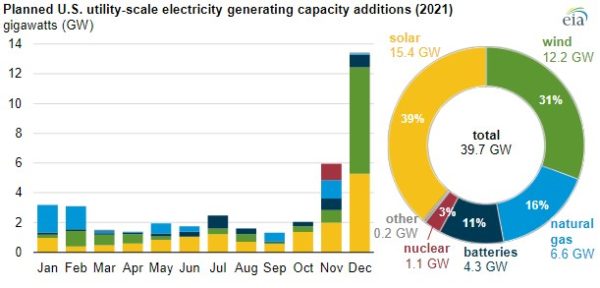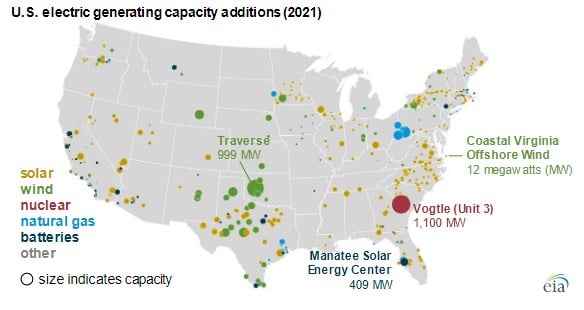Renewable energy resources will account for the majority of new U.S. electricity generating capacity in 2021, according to the U.S. Energy Information Administration (EIA).
In a “Today in Energy” report, the agency said it expects nearly 40 GW of new utility-scale capacity to start commercial operation this year. Of that, solar power will make up the largest share, 39%, followed by wind power at 31%. Natural gas additions will account for 11%, and a new nuclear reactor at Georgia’s Vogtle site is expected to make up about 3%. Notably, battery energy storage is projected to contribute 11% of expected new capacity.

Image: EIA
The EIA said project developers and plant owners expect utility-scale solar to set a new record by adding 15.4 GW of capacity to the U.S. grid in 2021. This new capacity will surpass last year’s nearly 12 GW increase, based on reported additions through October (6 GW) and scheduled additions for the last two months of 2020 (5.7 GW).
More than half of the new utility-scale solar capacity in 2021 is planned for four states: Texas (28%), Nevada (9%), California (9%), and North Carolina (7%). The EIA’s Short-Term Energy Outlook forecasts an additional 4.1 GW of small-scale solar capacity to enter service by the end of 2021.

Image: EIA
EIA said it expects utility-scale battery storage capacity to more than quadruple in 2021, with 4.3 GW slated to come online. The EIA called the rapid growth of renewables a major driver in the expansion of battery capacity. It also noted that the 409 MW Manatee center in Florida, among the world’s largest solar-powered battery projects, is scheduled to go online by late 2021.
This content is protected by copyright and may not be reused. If you want to cooperate with us and would like to reuse some of our content, please contact: editors@pv-magazine.com.









Why not report expected energy production instead of capacity? Given solar PV’s anemic capacity factor you may find that wind out-produces solar big time. Reporting capacity only is deceptive.
Nice to see this Joe! BTW, you may want to note that EIA uses AC numbers, so this is a whole lot more in terms of GW-DC.
Oh, and BTW Ken—you know that “why don’t you report output instead of capacity?” is the “the US is a republic not a democracy” of energy comments, right?
Political metaphors aside, citing capacity is deceptive. Here in the North East solar PV has a capacity factor of .13 to .15. Offshore wind has a capacity factor of .5. Some may read this article and believe that a kW of solar and a kW of wind are the same but when it comes to kWh, actual energy produced, wind out-produces solar PV by a factor of 3 or 4. Hydropower does even better since it can attain a capacity factor of nearly 1.0 as some micro and pico hydros do. A kW of hydro can out-produce a kW of solar PV by a factor of 6 or 7. Reporting capacity only is making solar PV appear to contribute more than it does.